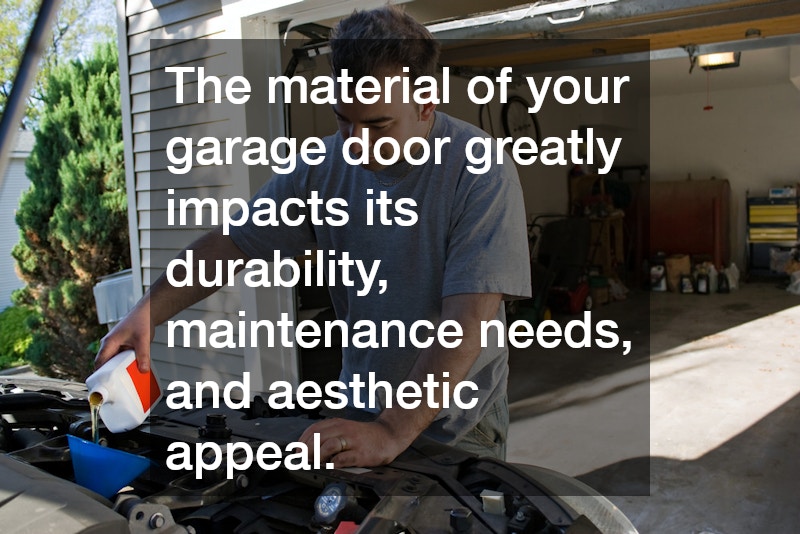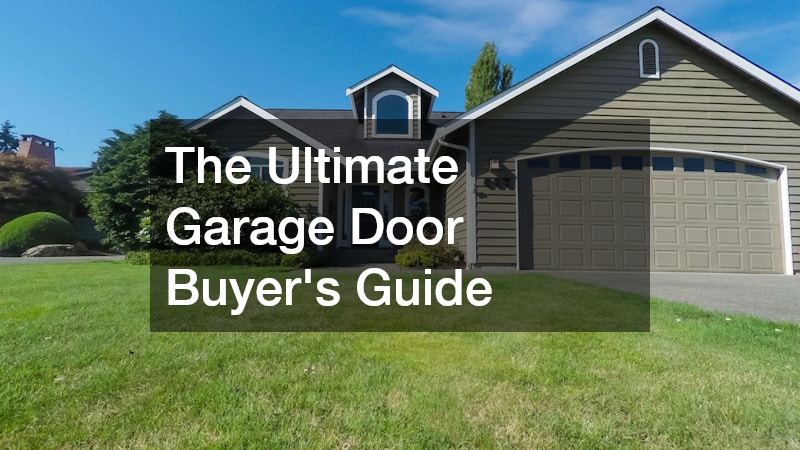
Garage doors are available in a variety of styles, each suited to different needs and aesthetic preferences. The most common types include sectional doors, which consist of panel sections connected with hinges, and roller doors, which roll up neatly above the garage opening. Other types like side-hinged doors and tilt-up canopy doors offer unique functionalities and design appeals.
Familiarizing yourself with these types can aid significantly in narrowing down your choices. Remember that each type offers varying levels of insulation, security, and ease of use.
Sectional garage doors are highly favored due to their robust construction and insulation capabilities. These doors operate on a vertical track, which means they require limited space indoors and can be automated easily. Roller garage doors, by contrast, are compact and good for space-savers, rolling up into a drum above the opening. They’re particularly popular for garages with less headroom. Each type has distinct advantages, but the choice largely depends on your specific requirements and the architectural style of your property.
When considering side-hinged garage doors, traditional charm comes to mind as they swing open like large barn doors. These doors can be automated, although they’re typically manual, allowing for easy maintenance. Tilt-up canopy doors, meanwhile, are a single solid piece that tilts upward, providing quick access, though they need more clearance space. Each type, whether offering modern or classic aesthetics, enhances curb appeal while serving functional purposes. The decision ultimately hinges on your budget, intended use, and style preferences.
Evaluating Material Options for Garage Doors
The material of your garage door greatly impacts its durability, maintenance needs, and aesthetic appeal. Common materials include steel, wood, aluminum, fiberglass, and vinyl, each offering unique benefits and drawbacks. Steel doors are highly durable and often feature a wood grain texture to mimic traditional wooden doors, without the associated maintenance. Wooden doors, while offering unparalleled natural beauty, require regular maintenance to prevent warping and weathering. Choosing the right material requires balancing priorities such as aesthetics, maintenance, and longevity.
Steel garage doors are typically the most cost-effective and durable option, making them a popular choice among homeowners. They resist impact and withstand harsh weather conditions better than most other materials. On the downside, steel can be prone to rust if not properly maintained or if it gets scratched. Wooden garage doors, on the other hand, not only offer aesthetic appeal but can also be custom-designed to suit your specific stylistic needs. However, they require treatment with special coatings to maintain their integrity over time.
Aluminum garage doors offer a modern look, lightweight. Fiberglass doors mimic the look of wood while being more resistant to damage from salty ocean climates, but they can fade over time. Vinyl doors are touted for their durability and do not rust or corrode, making them ideal for humid climates. Each material has its strengths and drawbacks, so consider your environment and maintenance preferences carefully. Understanding these characteristics will help you make an informed decision about the best material for your garage doors.
Consider Insulation Options for Energy Efficiency
Insulation in garage doors is pivotal for maintaining energy efficiency and comfort within your home. Well-insulated garage doors help regulate temperature, potentially reducing heating and cooling costs. The two main types of insulation for garage doors are polystyrene and polyurethane, with polyurethane being the denser and more efficient option. Insulated doors are measured by their R-value, with higher values indicating better insulation performance. Whether you use your garage as a workspace or simply to house vehicles, proper insulation can enhance comfort and efficiency.
Polystyrene-insulated doors are typically less expensive compared to polyurethane ones. While polystyrene offers adequate temperature regulation, polyurethane panels provide superior insulation due to their denser foam core. Moreover, insulation adds to the structural integrity of the garage doors, making them sturdier. Considering how you use your garage can guide you in choosing the right level of insulation. Even if you do not use your garage often, the additional insulation can add value to your home by increasing overall energy efficiency.
A well-insulated garage door provides noise reduction, crucial if your garage is attached to your living space. This could be particularly important in urban areas with high traffic. Besides reducing external noise, insulation helps maintain a quieter indoor environment, making it more conducive to various activities. Considering insulation options is an investment in comfort and the long-term efficiency of your home. Make sure to weigh the cost against energy savings and added comfort when evaluating your options.
Automatic vs. Manual Operation: What’s Right for You?
Deciding between automatic and manual garage door operation is another essential aspect to consider. Automatic doors have grown popular due to their convenience and can be operated with a remote or even a smartphone app in some cases. They often comprise safety sensors, which can halt or reverse the door if an object is detected. However, they typically come with higher upfront costs and require more maintenance than manual doors. Manual doors, while less convenient, are more affordable and have fewer components that can malfunction.
The decision between automatic and manual operation should factor in your lifestyle and budget. If you value convenience and have the budget for initial and potential maintenance costs, an automatic garage door is likely worth the investment. They are especially beneficial during bad weather, allowing you to open and close the door without leaving your vehicle. Manual doors, although requiring more physical effort, are durable and straightforward, with minimal maintenance needs. Your choice should align with your priorities, whether it be ease of use or cost-effectiveness.
Consideration of how frequently you’ll be using your garage can also inform this decision. Frequent use might necessitate the ease and speed of an automatic door. Alternatively, infrequent use could mean a manual door arrangement, saving costs and complexity. Evaluating your needs and what’s more important for your daily activities will profoundly impact your satisfaction and the functionality of your garage door purchase. Whether you opt for the automated convenience or the reliable simplicity of manual doors, it’s vital to weigh the benefits against your specific needs.
Budget Considerations and Final Thoughts
When purchasing garage doors, budget considerations are critical. High-end materials, insulation upgrades, and automation can add significantly to the cost, but they might also increase property value and long-term savings on energy bills. It’s beneficial to set a budget early in the shopping process, allowing you to focus on options within your financial means. Comparing quotes from multiple suppliers will ensure competitive pricing. Remember, while initial costs are important, consider longevity and energy savings as part of your investment.
Shopping for a garage door often involves prioritizing features against your budget constraints. At a minimum, ensure the door meets safety standards and suits your climate considerations, whether it is cold, hot, or humid. It’s possible to find high-quality doors at reasonable prices by exploring various brands and material options. Keep an eye out for promotions or discounts that might impact your choice without compromising quality. Align your purchase with your practical needs and aesthetic preferences, ensuring a balance between form and function.
Once you narrow down your choices, consider any potential long-term expenses such as maintenance, repair, or upgrades. A lower-priced garage door may cost more over time if it requires extensive upkeep. On the other hand, investing in a well-insulated automatic door might pay off through increased efficiency and convenience. Finalizing your decision should account for present and future needs, including ease of upgrades or modifications. Ultimately, the right garage doors enhance not just your home’s exterior, but also your lifestyle and satisfaction.





